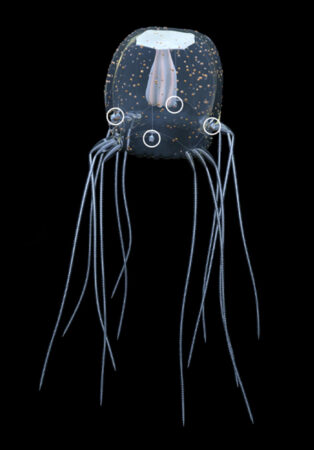For Caribbean box jellyfish, learning is literally a no-brainer.
In a new experiment, these animals learned to spot and avoid obstacles despite having no central brain, researchers report September 22 in Current Biology. This is the first evidence that jellyfish can make mental connections between events — such as seeing something and running into it — and change their behavior accordingly.
“Maybe learning does not need a very complex nervous system, but rather, learning is an integral part of nerve cells, or very limited circuitry,” says Jan Bielecki, a neuroethologist at Kiel University in Germany. If so, the new finding could help trace how learning evolved in animals.
The nervous system of a Caribbean box jellyfish (Tripedalia cystophora) includes four knoblike rhopalia that dangle off the bell of its body. Each rhopalium houses six eyes and about 1,000 neurons. The jellyfish use their vision to help steer between mangrove roots in the tropical lagoons where they hunt tiny crustacean prey.
Weaving between roots is no simple feat. Caribbean box jellyfish judge a root’s distance based on how dark it appears relative to surrounding water — that is, its contrast. In clear waters, only distant roots fade into the background, or have low contrast. But in murky waters, even nearby roots can blend into their surroundings.
Waters can become murky quickly due to tides, algae and other factors. Bielecki and his colleagues wondered if Caribbean box jellyfish could learn that low-contrast objects, which might at first seem distant, were actually close by.
The team put 12 jellyfish into a round tank surrounded by low-contrast, alternating gray and white stripes. A camera filmed the animals’ behavior for about seven minutes. At first, the jellyfish seemed to interpret the gray stripes as distant roots and swam into the tank wall.
But those collisions seemed to lead the jellyfish to treat the gray stripes more like close roots in murky water, and the animals started avoiding them. The jellies’ average distance from the tank wall increased from about 2.5 centimeters in the first couple of minutes to about 3.6 centimeters in the final couple of minutes. Their average bumps into the wall dropped from 1.8 per minute to 0.78 per minute.
“I found that really amazing,” says Nagayasu Nakanishi, an evolutionary biologist at the University of Arkansas in Fayetteville, who has studied jellyfish nervous systems but was not involved in the new work. “I never thought that jellyfish could really learn.”

Neurobiologist Björn Brembs views the results more cautiously, noting the small number of jellyfish tested and the variability in their performance. “I want this to be true, as it would be so very cool,” says Brembs, of the University of Regensburg in Germany. Experiments with more jellyfish could convince him that the animals really do learn.
In other experiments, Bielecki and his colleagues snipped rhopalia off jellyfish and placed those eye-bearing nerve bundles in front of a screen. Sort of like that scene in A Clockwork Orange, Bielecki says, except jellyfish eyes don’t have eyelids to hold open. The screen displayed low-contrast, light gray bars, while an electrode gave the rhopalia a weak electrical pulse, which mimicked the sensation of bumping into something.
This training caused the rhopalia to start responding to low-contrast bars that they had initially ignored. They started sending out the types of neural signals they are known to emit when a jellyfish darts away from an obstacle. This suggests that rhopalia alone can learn that seemingly distant, low-contrast obstacles are actually close enough to avoid — which, in turn, hints that the rhopalia are the Caribbean box jellyfish’s learning centers.
“That’s the coolest part of the paper,” says Ken Cheng, a behavioral biologist at Macquarie University in Sydney. “That gets us one step down into the, you know, wiring of how it works.”
For neurobiologist Gaëlle Botton-Amiot, tracing learning to the rhopalia raises new questions. “They have four of these things in their bodies, so how does that work?” she asks. “How is this coordinated?” And if a jellyfish loses one of its rhopalia, does it forget everything those eyes saw and neurons learned? Or do the other rhopalia remember it?
Botton-Amiot’s research at the University of Fribourg in Switzerland hints at similar learning abilities in sea anemones. Like jellyfish, they belong to a group of animals called cnidarians. “Showing that cnidarians that are so different [can both learn] means that it’s probably super widespread within them,” she says, and that perhaps their common ancestor could learn too.
“Maybe [learning] actually evolved multiple times in the evolution of nervous systems,” Nakanishi says. Uncovering the cellular and chemical machinery behind learning in jellyfish or other animals could shed light on this. “If there’s a lot of similarities in the mechanism of how they learn, then that would be suggestive of common ancestry,” he says. “But if they evolved independently, then you would perhaps expect very different mechanisms of learning.”




Comments are closed.